MARIANI’SVirtual Gourmet
February 19,
2012
NEWSLETTER
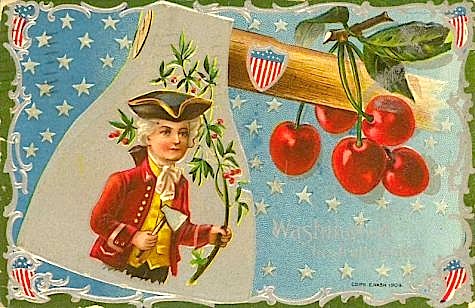
Happy Presidents' Birthday!
❖❖❖
THIS WEEK
by John Mariani
NEW YORK CORNER
RedFarm
by John
Mariani
FIVE WAYS TO UP YOUR DIM SUM IQ
by Ed Schoenfeld
by John Mariani
❖❖❖
by John Mariani
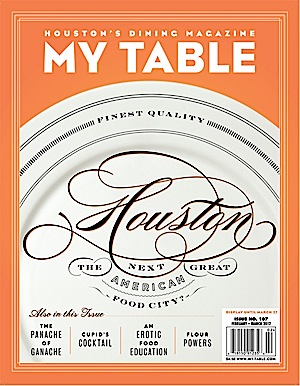 The
new issue of My Table,
a magazine that has since 1994 chronicled the growth
and variety of Houston's dining scene, poses the
question "Is Houston the Next Great American Food
City?" in an article by Misha Govsteyn, who
pointedly shows how diverse the offerings are, from
Tex-Mex to Vietnamese, from Gulf seafood to Texas
game, from Little India to one of the largest
Chinatowns in America. He goes on to say that
Houston does not currently have a restaurant to rise
to the Olympian heights of The French Laundry in
Napa Valley, Le Bernardin and Jean Georges in New
York (curiously enough, a Jean Georges restaurant in
Houston named Bank flopped badly after one
year). Indeed, if French restaurants are the
measure of Michelin-star excellence, Houston is
seriously deficient in that department, though, with
the exception of the great Tony's--whose menu
superbly straddles French, American, and Italian
cuisine, the city has few Italian restaurants of any
note.
The
new issue of My Table,
a magazine that has since 1994 chronicled the growth
and variety of Houston's dining scene, poses the
question "Is Houston the Next Great American Food
City?" in an article by Misha Govsteyn, who
pointedly shows how diverse the offerings are, from
Tex-Mex to Vietnamese, from Gulf seafood to Texas
game, from Little India to one of the largest
Chinatowns in America. He goes on to say that
Houston does not currently have a restaurant to rise
to the Olympian heights of The French Laundry in
Napa Valley, Le Bernardin and Jean Georges in New
York (curiously enough, a Jean Georges restaurant in
Houston named Bank flopped badly after one
year). Indeed, if French restaurants are the
measure of Michelin-star excellence, Houston is
seriously deficient in that department, though, with
the exception of the great Tony's--whose menu
superbly straddles French, American, and Italian
cuisine, the city has few Italian restaurants of any
note. Govsteyn correctly feels that the national media have largely ignored Houston's culinary progress but insists that just in the past year and following throughout 2012, a new generation of young chefs will truly transform the staid image of the city. "Expect a sudden renaissance across the entire spectrum of restaurants high and low," he writes.
I have always been a big booster of Houston's restaurants, because for the last decade the evolution towards more and more serious (I did not say "formal") dining has been steady and sure, which includes the re-configuring of longtime standard bearers like Tony's and Robert Del Grande's RDG Bar Annie, along with exciting Mexican restaurants like Hugo's, civilized steakhouses like Pappas Bros., and ethnic eateries of every stripe. Oddly, Houston is not awash with terrific barbecue, with the large, expansive Goode Co. leading a small pack.
On occasion, when asked what are America's best restaurant cities, I have sometimes surprised people by putting Houston just behind New York, Chicago, San Francisco, New Orleans, and L.A., and ahead of Boston, DC, Miami, and its rival Dallas. I, too, am looking forward to my annual trip in 2012, anxious to see if Govsteyn's predictions pan out. I expect they will, and I can't wait to tell you about them. For now, here are three places that opened in 2011 that give evidence of continuing excellence.
EL REAL TEX + MEX
1201 Westheimer
713-524-1201
www.elrealtexmex.com
Houstonians will
argue endlessly about which hole-in-the-wall Tex-Mex
place is the best in their city— Teotihuacan
Cafes for the $4.99 Breakfast Grande, the
original Ninfa’s
on Navigation for the signature tacos al carbon,
or Mission
Burritos for their overstuffed namesake
item. None,
however, has the breadth and depth, not to mention
Texas white guy swagger, that El Real does. Award-winning
Chef Bryan Caswell, restaurant developer Bill Floyd,
and Rob Walsh, author of The Tex-Mex Cookbook, didn’t want to upgrade Tex-Mex food,
they just wanted to do it better than anyone in
Houston and, with a lot of decorous respect, they
succeeded admirably and with plenty of fun.
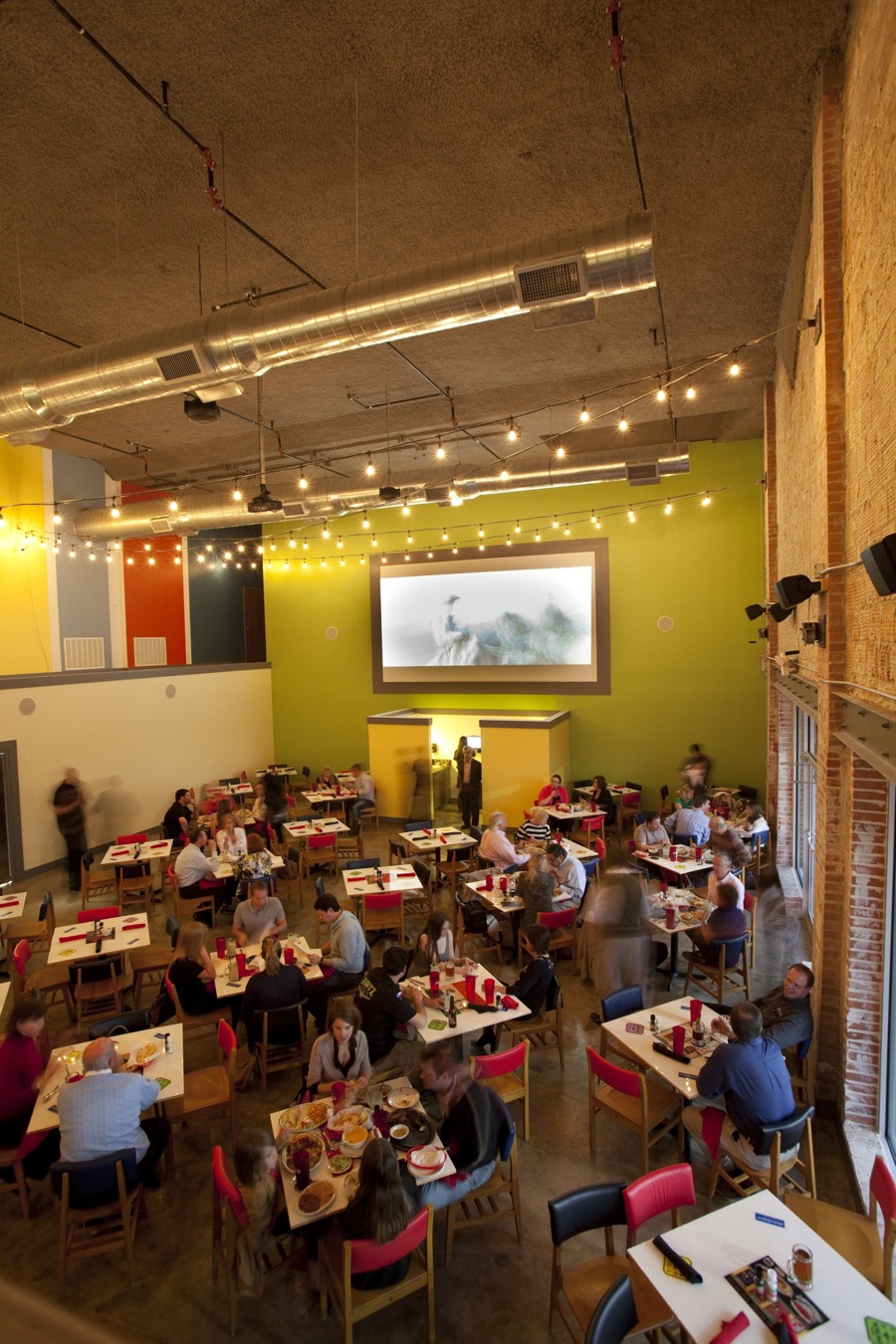 Located
in
the restored Tower Theater (above) in the Montrose
neighborhood, done up in Texas and Mexican kitsch,
and playing Clint Eastwood movies against the wall,
El Real is the real deal, with a menu way too long,
but I ripped through as many dishes as possible and
would return any time for the queso flameado with
chorizo; green chile posole; the San Antonio Puffy
Taco Plate; the Enchiladas #10, with cheese, chile
con carne and chili con queso; and Chingo Bing, a
smoked chicken relleno, chicken enchilada with salsa
verde, and a pork tamale.
Located
in
the restored Tower Theater (above) in the Montrose
neighborhood, done up in Texas and Mexican kitsch,
and playing Clint Eastwood movies against the wall,
El Real is the real deal, with a menu way too long,
but I ripped through as many dishes as possible and
would return any time for the queso flameado with
chorizo; green chile posole; the San Antonio Puffy
Taco Plate; the Enchiladas #10, with cheese, chile
con carne and chili con queso; and Chingo Bing, a
smoked chicken relleno, chicken enchilada with salsa
verde, and a pork tamale.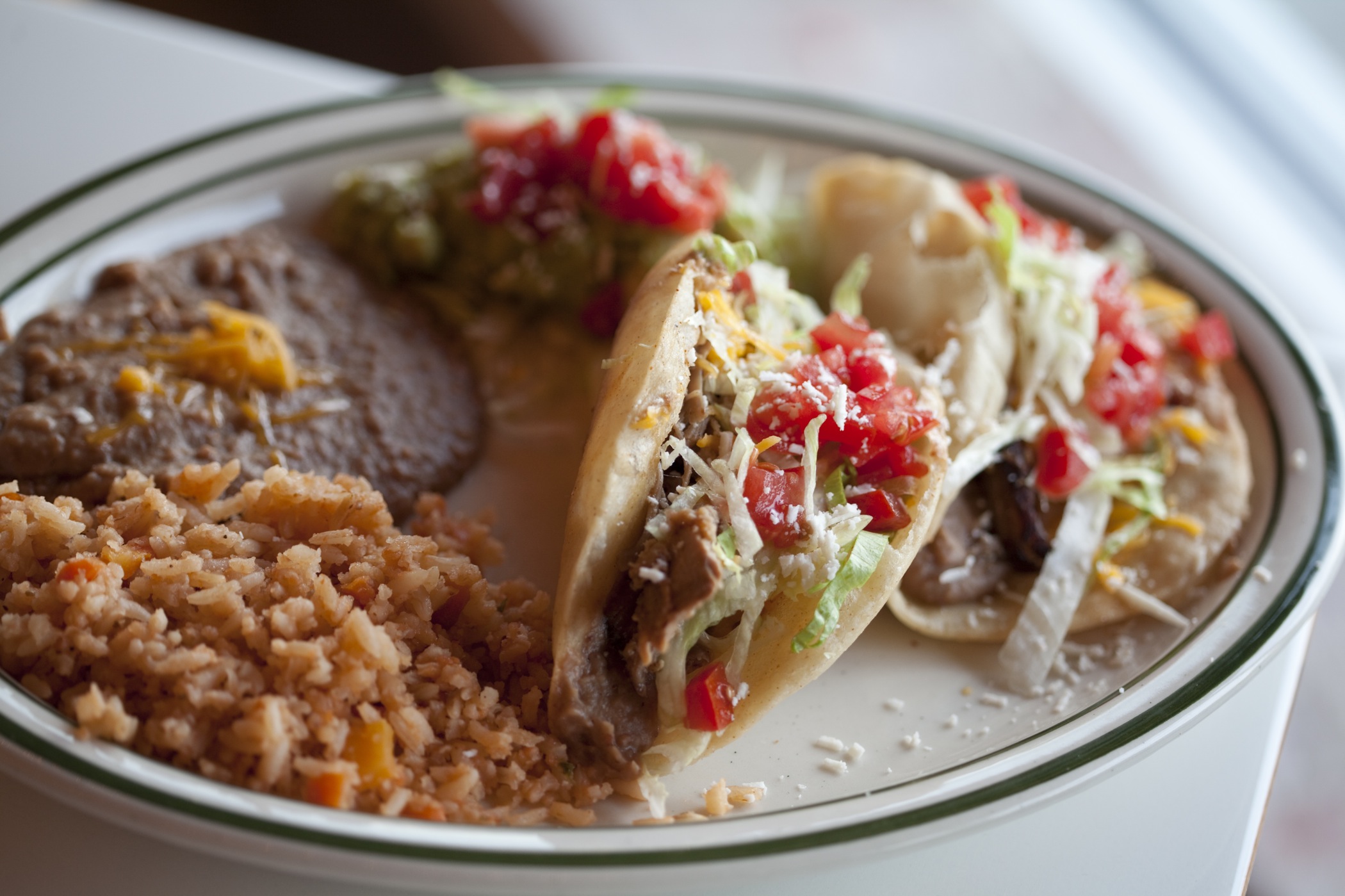
Caswell's rep, after a stint with Jean
Georges Vongerichten, was made at the seafood
restaurant REEF, which Floyd ran, and Walsh had been
food critic for the Houston Press before going over to the
restaurant biz.
The menu casts a very wide net,
with 15 side dishes alone, including a fried
egg. There are some very well-priced lunch
specials, like the #4--tacos al carbon, fajita,
green chile posole,
tamale, rice and refried beans for thirteen bucks.
Tacos here are puffy "San Antonio
style," which means nice and chewy. You can go for
an appetizer or two, but, as usual in Tex-Mex, so
many flavors and preparations overlap, like chile
and guacamole, it's better to move right to the
heftier courses. The five-label wine list is
not worth mentioning, and I'm a little surprised
there aren't more beers offered. The
margaritas, by the way, are first rate. A pitcher of
them is $29.50--about what two cocktails would cost
at some swanky Houston bar.
El Real is open daily for lunch and dinner.
QUATTRO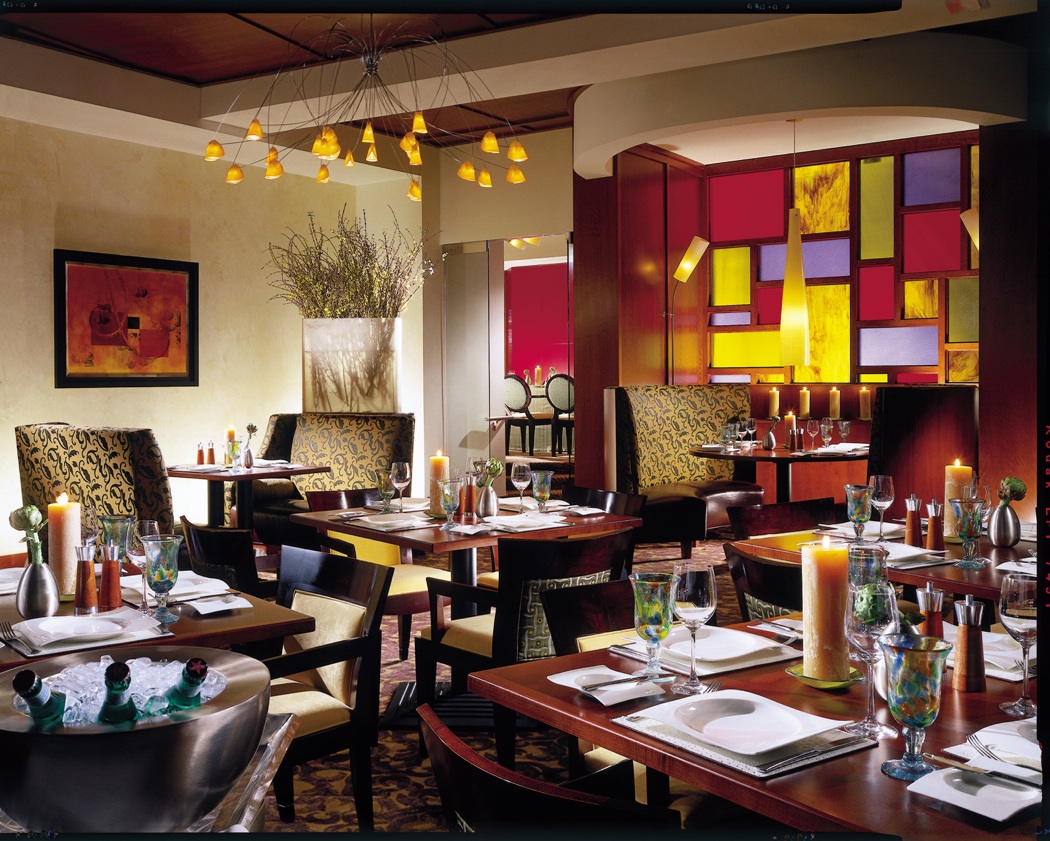
The Four Seasons Hotel
1300 Lamar Street
713-276-4700
www.quattrorestauranthouston.com
For
decades now The Four
Seasons Hotel in downtown Houston has tried to find
a winning formula for its upstairs dining room, and
I think I've tried all the incarnations over the
years. Its newest, Quattro, strikes me as its best
and certainly most lively, rescuing this space from
neglect by giving it sunshine, Mondrian-like colors,
Murano glass and an Italian chef who knows well the
Four Seasons style, having worked with the group
since 2000 in hotels from Hawaii to Budapest.
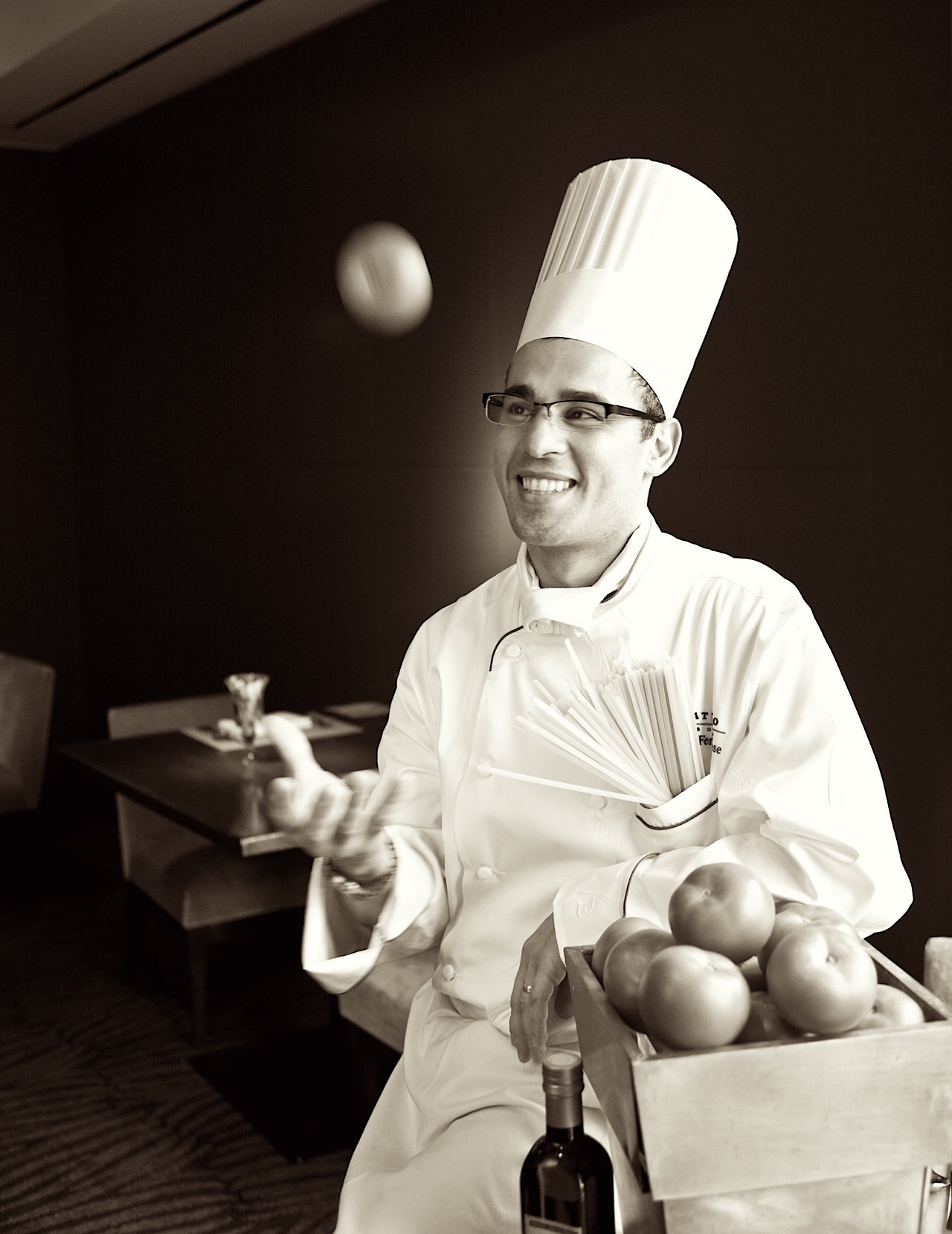 Maurizio Ferrarese was
born in Vercelli, Italy, arriving in Houston two
years ago, imprinting his own stamp indelibly on a
menu that had long been a mishmash of Tex-Mex and
continental cooking with no personality. There is
also a wine bar here that works well especially
after 5 PM, with a long list of wines by the glass.
Maurizio Ferrarese was
born in Vercelli, Italy, arriving in Houston two
years ago, imprinting his own stamp indelibly on a
menu that had long been a mishmash of Tex-Mex and
continental cooking with no personality. There is
also a wine bar here that works well especially
after 5 PM, with a long list of wines by the glass.
His menu, which even includes
pizzas, hits many expected notes but he marks little
chef's hats next to those dishes he calls "Chef
Maurizio's Toque Top Pick," and he offers guests a
chance to have him cook a tasting menu, too.
You might begin with buffalo
mozzarella with glazed shallots and tomato confit,
or a very good, creamy vitello tonnato that is all
about subtlety. There is always a risotto
among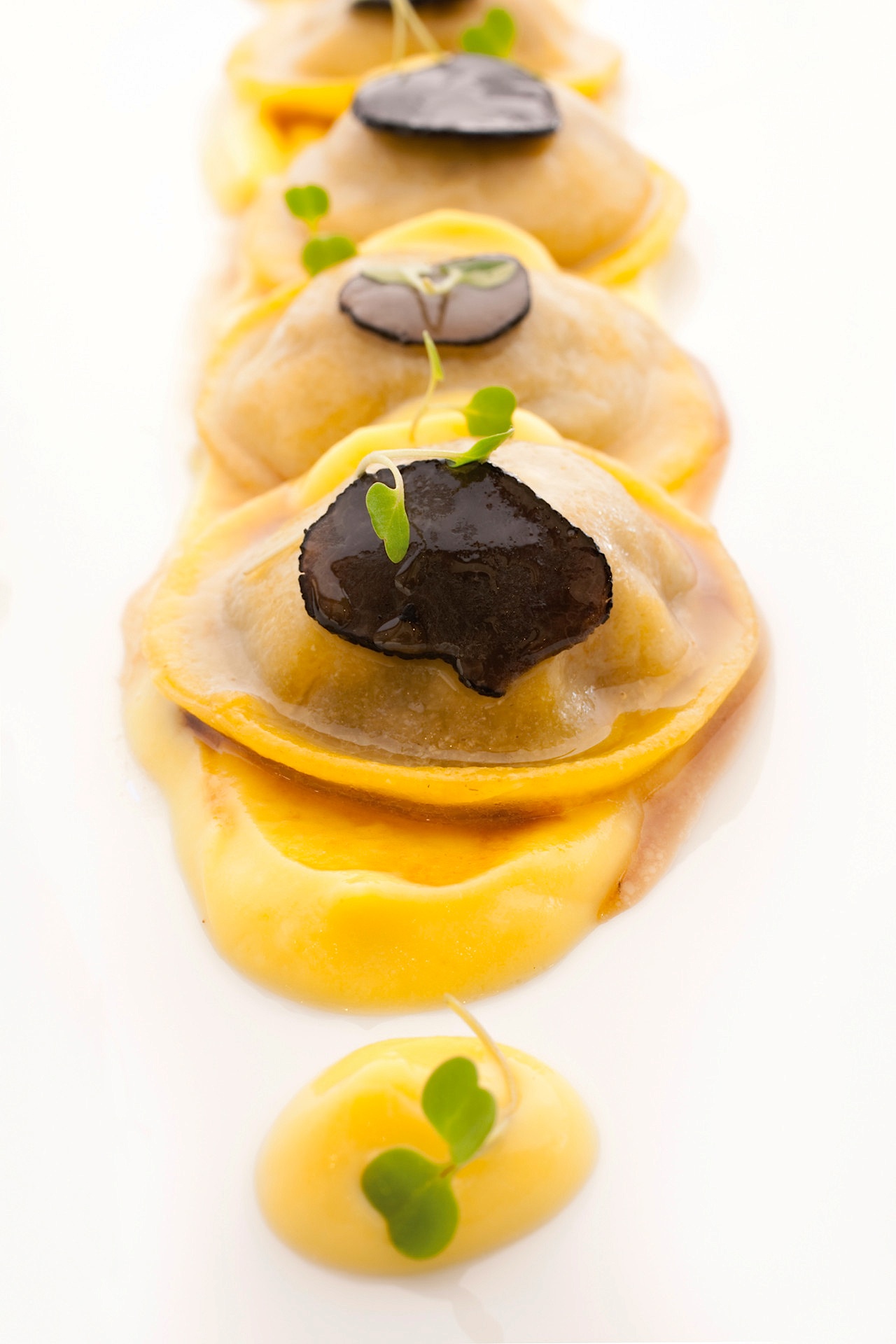 the pastas, and the one I
tried, with four cheeses and black truffles, would
easily slip onto any menu in Ferrara. I was
not in love with the bland duck ravioli in a murky
lentil ragôut.
the pastas, and the one I
tried, with four cheeses and black truffles, would
easily slip onto any menu in Ferrara. I was
not in love with the bland duck ravioli in a murky
lentil ragôut.
It's always hard not to order cotoletta of
veal alla
milanese when I see it on a menu, and
Quattro's is first rate, the breading crisp and
buttery, the veal full of flavor, with bright salad
and tomatoes on top. Nothing could improve on an
impeccably cooked branzino
alla piastra, grilled, with mixed
vegetables.
I very much like it when a
substantive wine list is written on the back of a
menu, as is Quattro's, and, while understandably
rich in Italian bottlings, there are global
offerings too, and at least 30 wines by the glass.
Quattro is open
for breakfast, lunch and dinner daily. Antipasti
run $10-$18, pastas (half/full portions) $13/$22
to $15/$26, main courses $28-$49. There is
also a new children's menu.
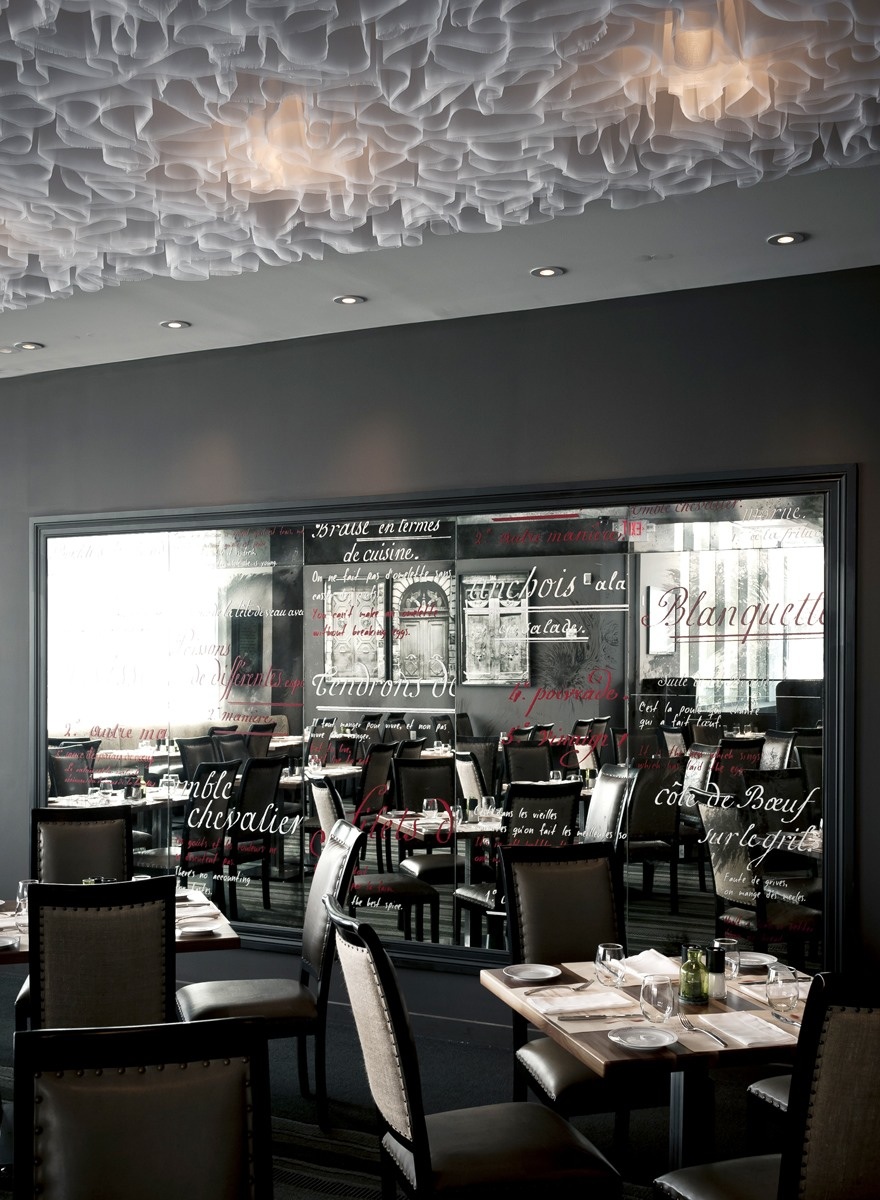 philippe
philippe1800 Post Oak Boulevard
713-439-1000
www.philippehouston.com
When Roanne-born Philippe Schmit (below) became chef in 2004 at Bistro Moderne in Houston, the kudos went flying. He came from starry NYC restaurants like Le Bernardin, Orsay, and La Goulue, and before that at Paris restaurants Le Carré des Feuillants, Pavillon Élysée Lenôtre and Jacques Cagna. With plenty of Gallic joie de vivre, he adapted quickly to being what he calls a "French Cowboy," a style that he demonstrates throughout his lengthy menu with a little something for everyone.
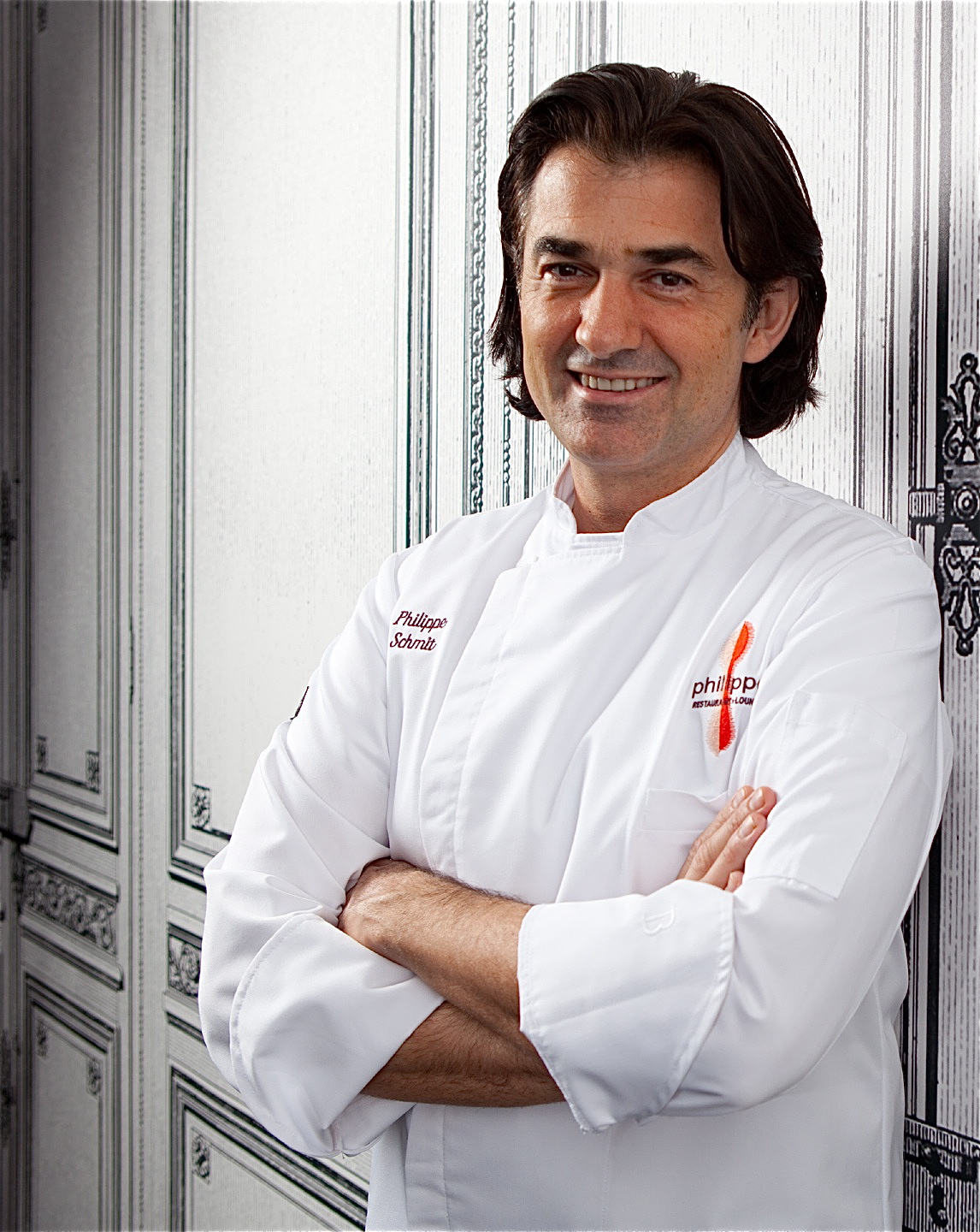
The two-level space is enormous, with an industrial look that begins downstairs with a 75-seat lounge where movies are projected against the wall. Up a huge stairway you come to a 120-seat dining room with a beautiful stenciled mirror, glass-walled kitchen and 16-seat chef's table that blends a Texas mesquite table and goat's hide chairs with Marie-Antoinette lithograph wallpaper. There's a private dining room upstairs to seat up to 60 more people. Philippe's press release says the restaurant is located "on Houston's Champs Élysée," whose comparison will, I suspect, come as quite a surprise to anyone who has strolled that boulevard from Place de la Concorde to the Arc de Triomphe (even if the Champs Élysée has become so commercialized as to bear some faint similarity to Houston's snazzy Post Oak Boulevard).
So this is a big, full-blown operation, with a menu whose categories are called way too cutely "Flirtations," "Sumptuous," "Au Naturel," "Contained Decadence," "Hot & Round," "Satisfaction," "Main Attraction," and "Unrestrained," with 47 items (including nine desserts).
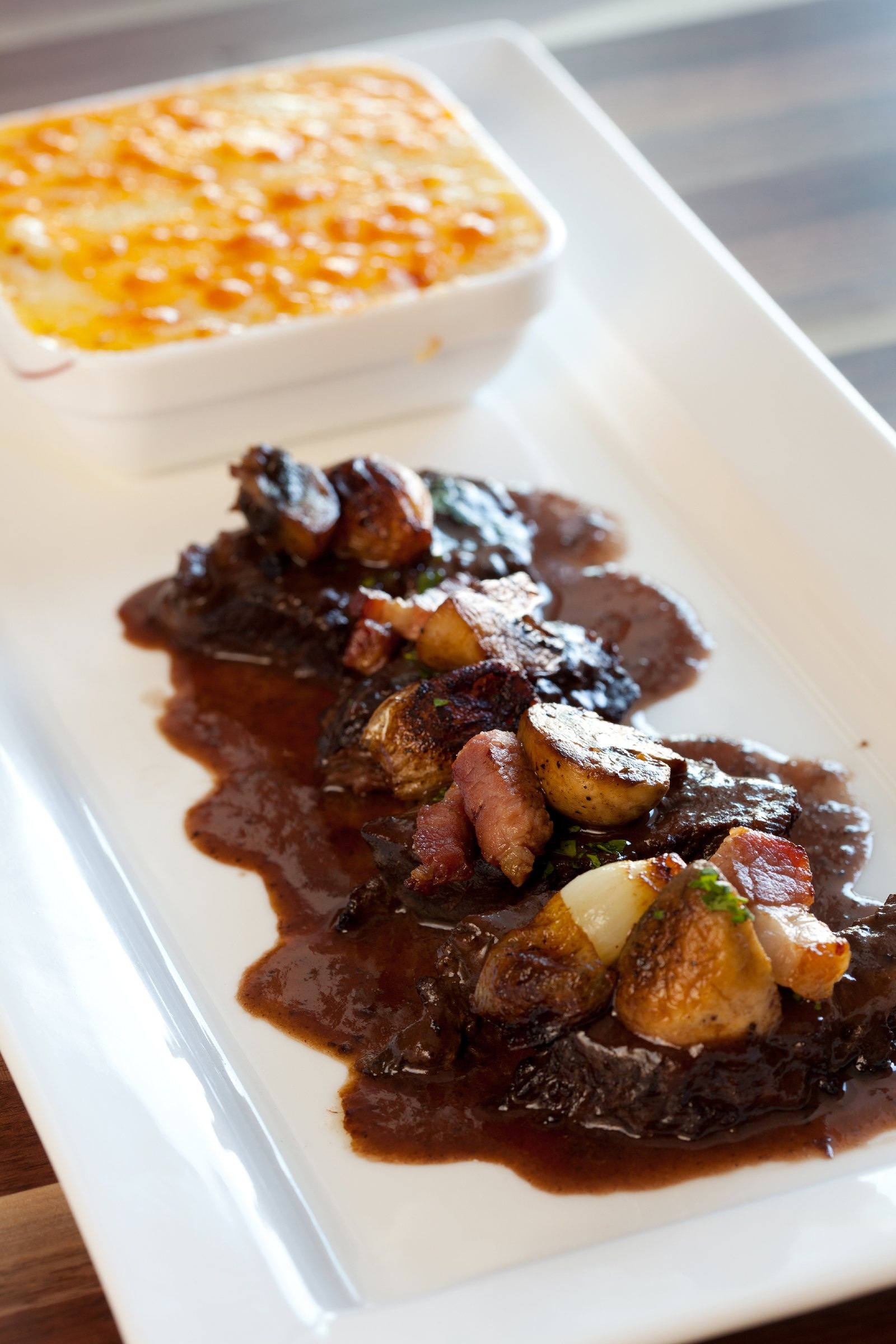 No kitchens I
know of can pull all that off with aplomb, so you
have to choose wisely at Philippe's to get the best
out of it. And the best are his French dishes,
ranging from a lobster bisque with poached cod
quenelles of a blissful lightness that would please
any Parisian gourmand to rich "drunken foie gras,"
powerfully marinated in Sauternes and
Armagnac. So, too, a simply baked lemon sole
with a savory compound butter, polenta and truffle
Port sauce had real authority behind it. As in all
restaurants with a demanding French chef, desserts
are excellent, especially the updated traditional
caramel chocolate mousse with caramel ice cream and
salty cashews.
No kitchens I
know of can pull all that off with aplomb, so you
have to choose wisely at Philippe's to get the best
out of it. And the best are his French dishes,
ranging from a lobster bisque with poached cod
quenelles of a blissful lightness that would please
any Parisian gourmand to rich "drunken foie gras,"
powerfully marinated in Sauternes and
Armagnac. So, too, a simply baked lemon sole
with a savory compound butter, polenta and truffle
Port sauce had real authority behind it. As in all
restaurants with a demanding French chef, desserts
are excellent, especially the updated traditional
caramel chocolate mousse with caramel ice cream and
salty cashews.By trying to play the French Cowboy, however, Chef Philippe hasn't quite grasped the nuances of a dishes like spicy duck confit tamales with sun-dried tomatoes, whose amalgamation didn't really seem to derive from France or Texas. Pork ravioli came with a chorizo "smoothie" that seemed nothing more than playful. And a Jack Daniel's-laced veal stock clashed with the delicacy of baked scallops.
Next time I go to Philippe's, I'll go early, sit down and order any of the French dishes, knowing that a chef of his background--soon to be awarded the illustrious title of Maître de Cuisiniers de France--will deliver all I crave of that kind of cooking. For the Texas side, I'd go to some old favorites around Houston.
Philippe is open Mon.-Fri. for lunch, Mon.-Sat. for dinner. Appetizers $6-$16, main courses $17-$64.
❖❖❖
NEW YORK CORNER
by John Mariani
RedFarm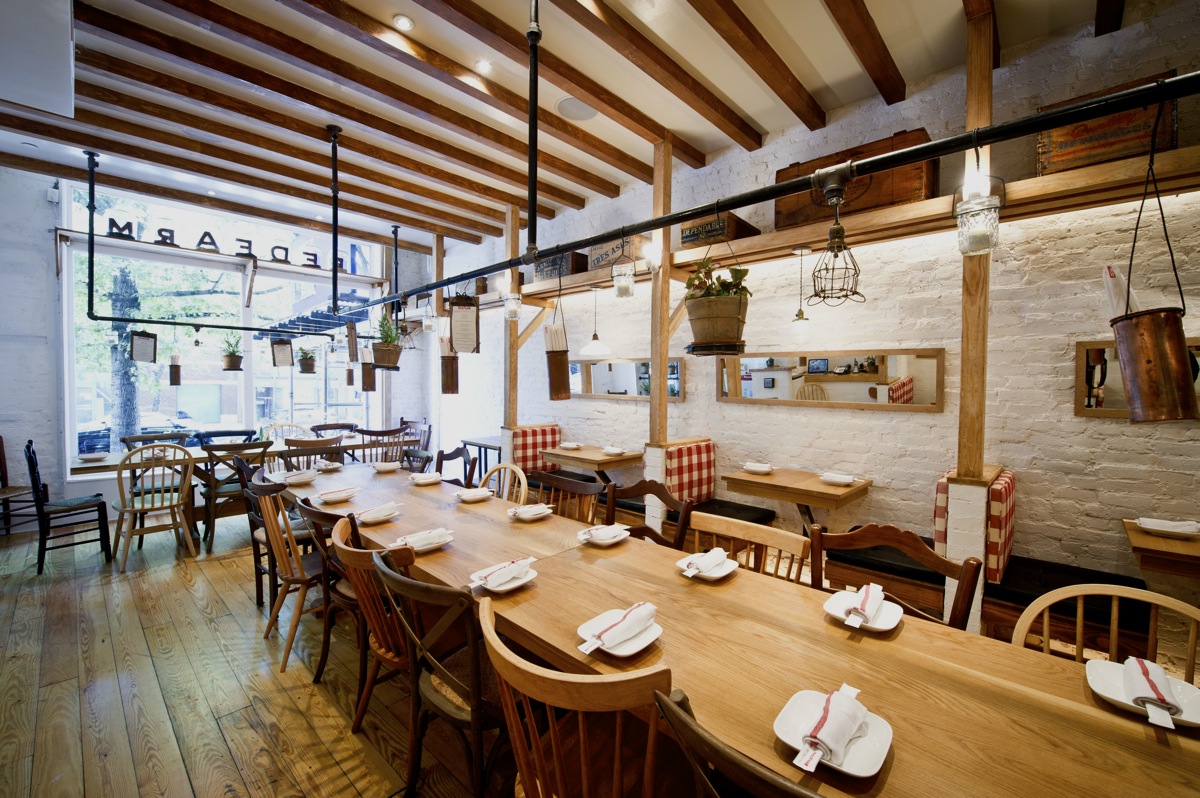
529 Hudson Street (near
West 10th Street)
212-792-9700
www.redfarmnyc.com
First, a few words about
Ed Schoenfeld: Back in the late
1960s, when most Chinese restaurants in America were
still serving egg foo yung
and chow mein, Ed Schoenfeld, a nice Jewish kid from
Brooklyn, developed a
passion for authentic Chinese food that went far
beyond Neil Simon’s contention
that “All Jews know two things: guilt and where to
find a Chinese restaurant
open on Sunday.”
And
with his help and guidance, an odd thing happened:
Starting around the
mid-‘70s, NYC’s far east side, near the U.N., saw
one, then two, then more very
upscale Chinese restaurants that featured the
cooking of Sichuan and Hunan,
known for their fiery chile-spiced dishes—the best
known being General Tso’s
chicken. Milder
Cantonese cuisine
faded fast, even in Chinatown, and by the end of the
decade you were as likely
to find dishes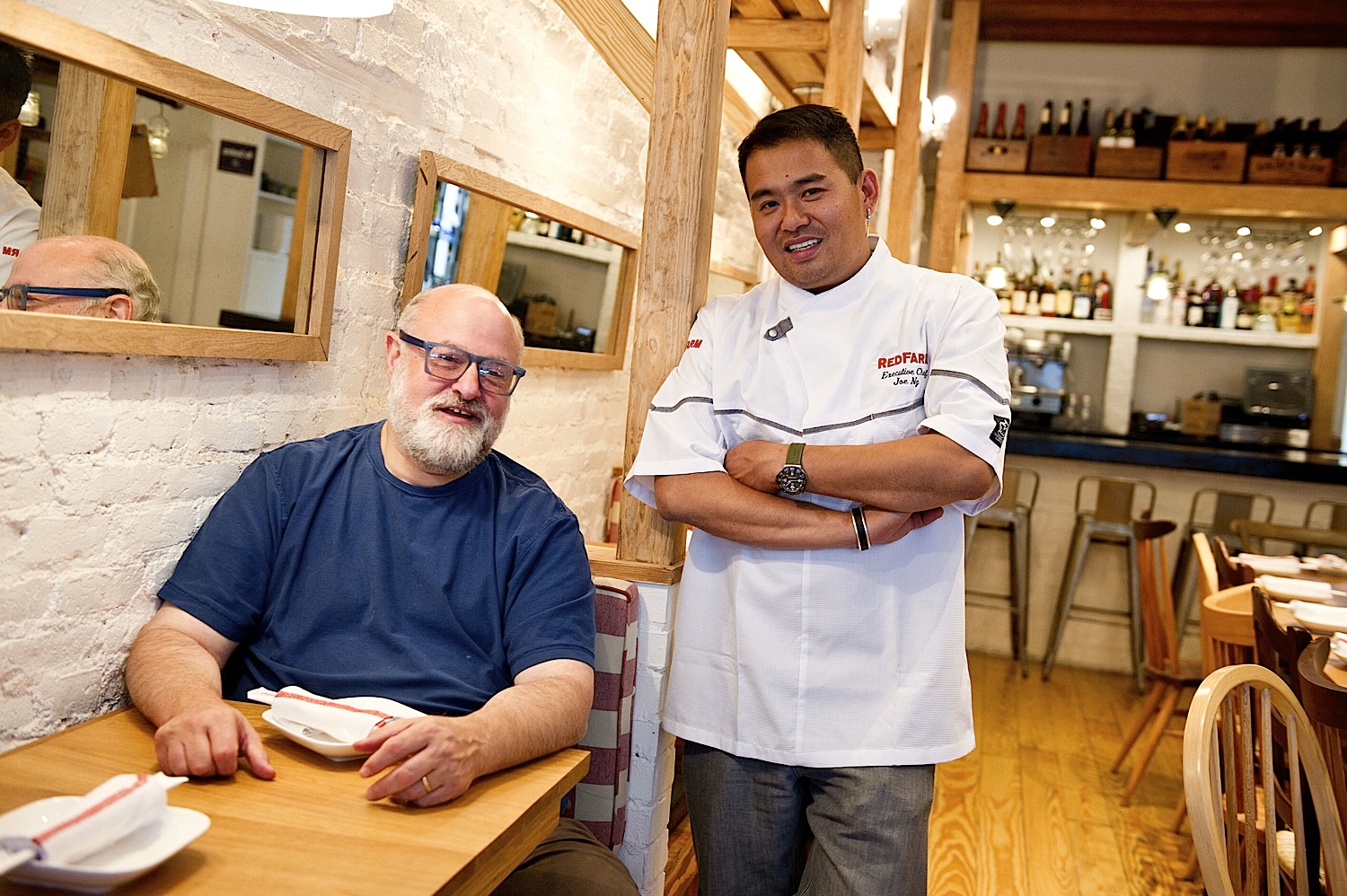 (which Ed
Schoenfeld helped pioneer as a consultant) like
hot-and-sour soup,
lobster soong,
Hunan
honeyed ham on white bread, cold noodles with sesame
sauce, crispy walnuts and
others became totemic overnight in Chinese
restaurants around the U.S., most,
for some reason, located in strip shopping malls.
(which Ed
Schoenfeld helped pioneer as a consultant) like
hot-and-sour soup,
lobster soong,
Hunan
honeyed ham on white bread, cold noodles with sesame
sauce, crispy walnuts and
others became totemic overnight in Chinese
restaurants around the U.S., most,
for some reason, located in strip shopping malls.
Schoenfeld was involved with
famous restaurants like Uncle Tai’s, David Keh, Pig
Heaven, and Auntie
Yuan, and,
throughout
the next two decades always seemed to be the
consultant to new Chinese restaurants
everywhere. Still, this newly popular cooking style
developed a sameness on menus that did nothing help
the cuisine to
evolve. So, when Schoenfeld
and Chef Joe Ng (left),
with restaurateur
Jeffrey Chodorow, decided to open RedFarm, there
was no attempt to be authoritative; instead, they’ve
composed a menu that is
fascinating for its global reach, if always with
Asian and Chinese
underpinnings. Thus,
you’ll find a
pastrami egg roll on
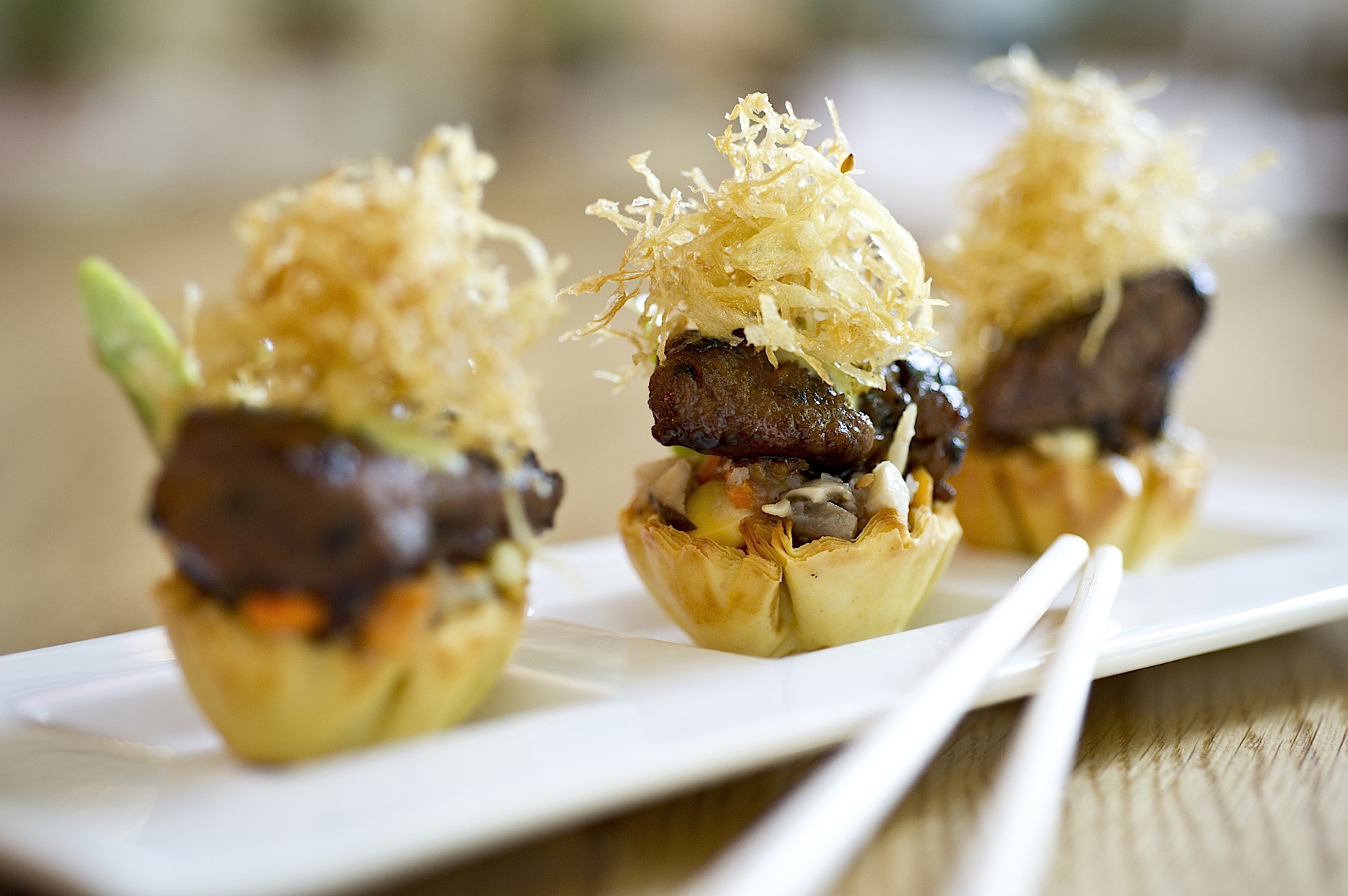 the menu,
alongside mushroom spring rolls crafted to look like
a chanterelle.
the menu,
alongside mushroom spring rolls crafted to look like
a chanterelle.
The
small dining room is set in an
1828 West Village townhouse, with white brick walls,
exposed wooden beams, five
booths and two communal tables, totaling 42 seats. It’s bright and colorful, kind
of like a Cracker Barrel done
with urban cool. Owing to its size, the drawback
here is that RedFarm doesn’t take reservations, but
if you show up, they’ll
give you an estimated waiting time, take your cell
phone number, and text you
20 minutes before they expect a table to turn. Show up at 5 PM or after
10 PM and you have an even better shot.
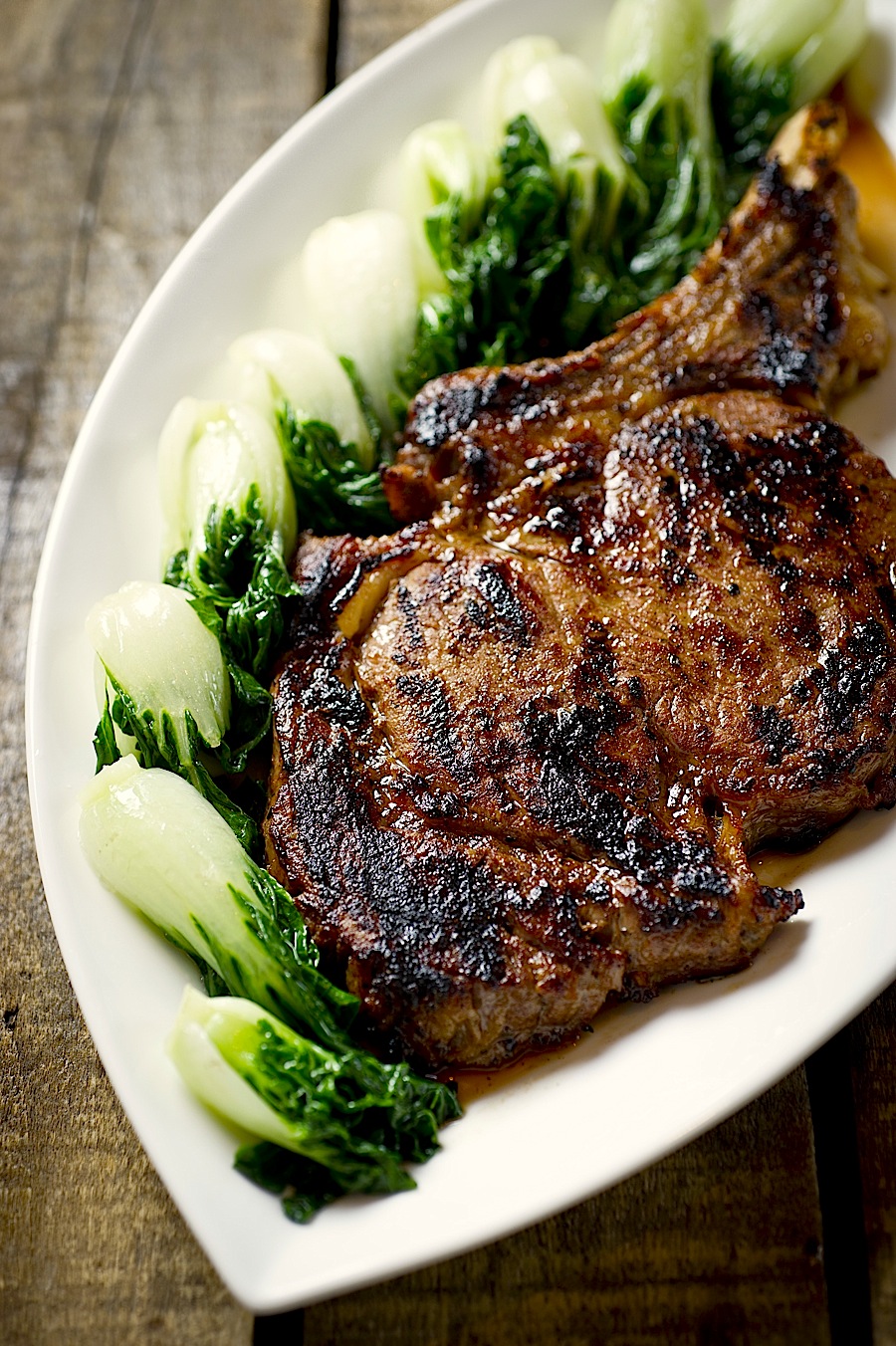 The
menu changes frequently, so I
asked Schoenfeld, who has more than once been
likened to Rob Reiner with big glasses, to send out
whatever he wished that night. We began with those
crunchy
mushroom and vegetable springs rolls and the
pastrami egg rolls—both
delicious—along with lightly smoked salmon and
eggplant bruschetta, and
Kowloon-style filet mignon tarts (above). The
food is fun and not to be taken too
seriously, with none of the pretensions of
“modernist” chefs who think they are
creating artwork.
The
menu changes frequently, so I
asked Schoenfeld, who has more than once been
likened to Rob Reiner with big glasses, to send out
whatever he wished that night. We began with those
crunchy
mushroom and vegetable springs rolls and the
pastrami egg rolls—both
delicious—along with lightly smoked salmon and
eggplant bruschetta, and
Kowloon-style filet mignon tarts (above). The
food is fun and not to be taken too
seriously, with none of the pretensions of
“modernist” chefs who think they are
creating artwork.
Steamed lobster dumplings came
with a lush mushroom ragôut (and Schoenfeld is
an authority on Chinese
dumplings; see his guide below) from a dim sum
section of the menu (enlarged at brunch). Main
courses followed: amazingly juicy grilled, marinated
Prime ribeye (left)
with baby bok
choy; okra and Thai eggplant yellow curry; Dungeness
crabmeat and rock crab
with “long life” noodles; and soft and crunchy
vegetable fried rice—better than
any version of that dish I’ve ever had.
We finished off with a singularly New York
style chocolate pudding with
whipped cream.
We were happy as clams feasting
on
this family-style array of novel dishes, and it was
doubly enjoyable because I
got to renew my acquaintance with Schoenfeld, whose
tales of the history of
Chinese food in America could fill a book—one I hope
he writes some day.
RedFarm is open for dinner nightly and for
brunch Sat. & Sun. Starters and dim sum
$7.25-$19, main
courses $14-$39.
Five
Ways to Up Your Dim
Sum IQ by Ed Schoenfeld 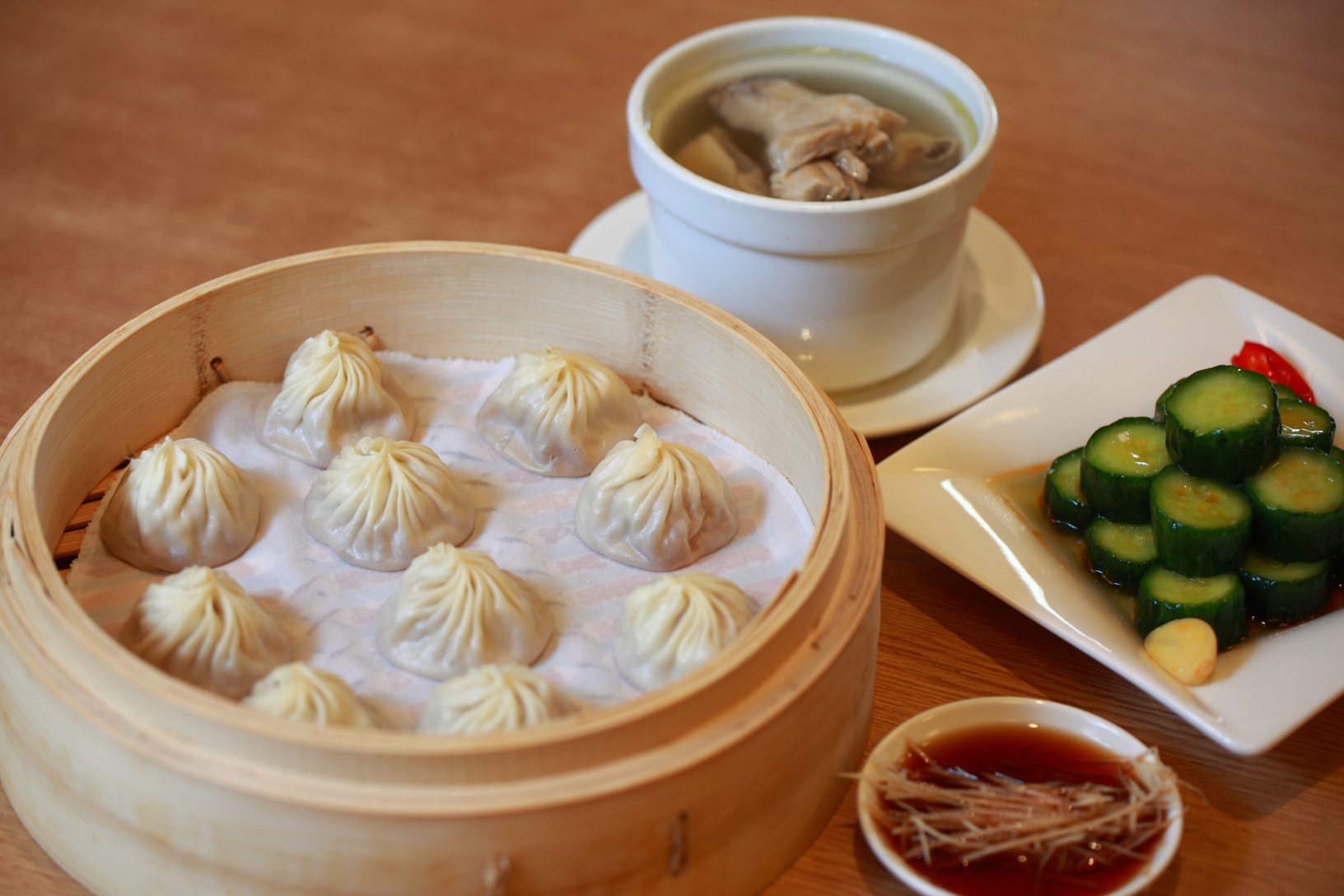
1. Go early: Most large
2. Look for the fresh
stuff : One
of the biggest dim sum dining challenges is
determining which items are freshest. In
particular,
hot carts containing steamed items may keep your
food warm and immediately
available, but also continue to cook it. Dough and
fillings can easily be past their
prime after just a few minutes of dining room
circulation. So here are a few tricks:
●
Look for kitchen runners (servers whose job it is
to transport freshly made food from the kitchen to
the dining room) carrying trays
stacked high with steam baskets. Chances are
they’ve been sent out to
replenish diminishing supplies of whatever that
particular cart is
hawking. Feel free to take your check and walk
over to the newly stocked cart to
score a freshly cooked item.
• A related strategy is to pay attention to how
many orders of a particular item are available on
passing carts. If there is only one
of something, chances are excellent that it is the
last of a batch and
therefore less fresh than one would like.
Conversely, if there are many orders of
something, chances are that it’s fresh.
• Look closely at the food. If it looks like the
seams of a dumpling are detaching from one another
or the item is broken in any way,
it’s likely to be past its prime.
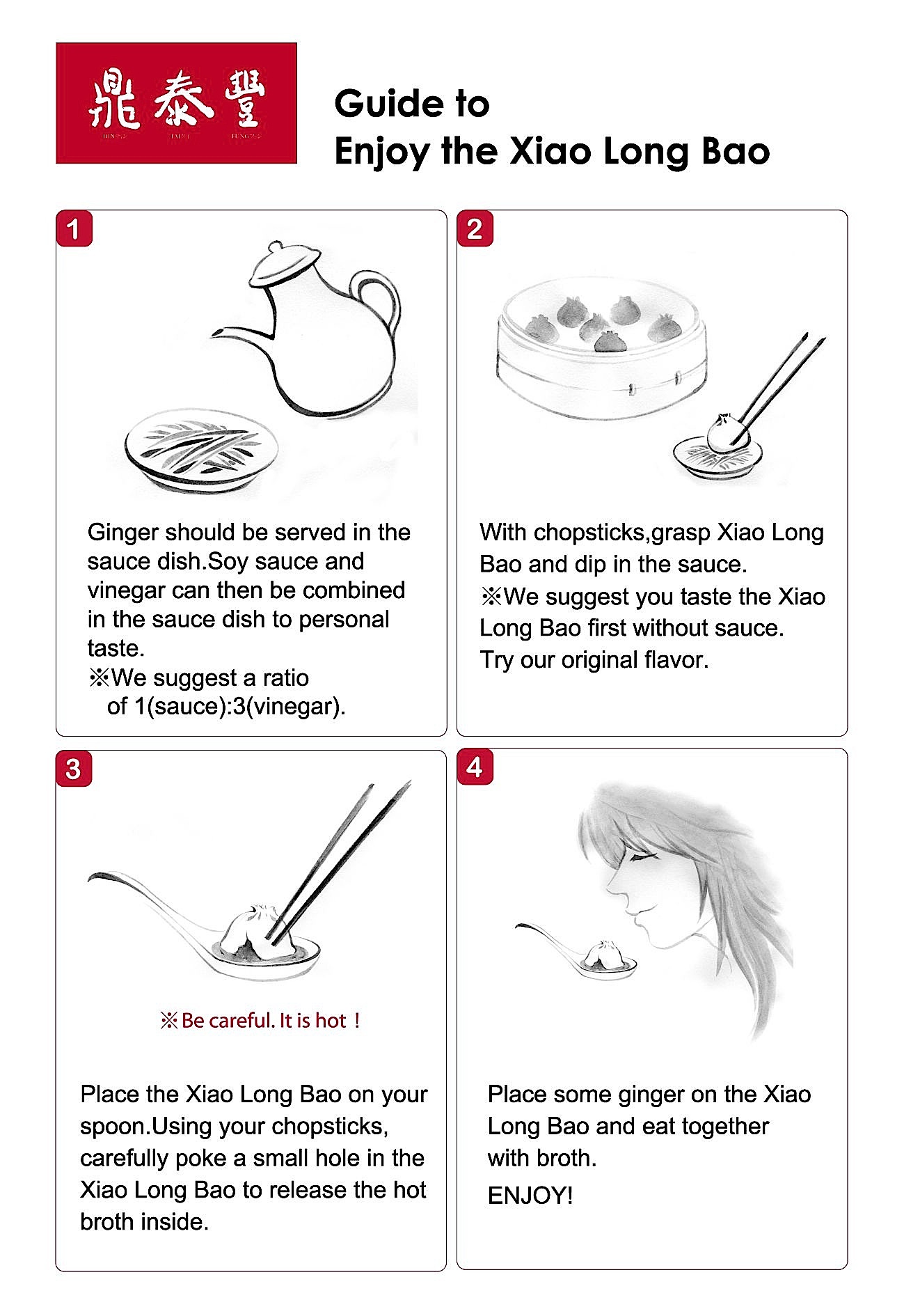 3. Choose
your beverage: All dim sum
restaurants charge for tea on a per-person basis.
Basically, it’s a cover charge that everyone pays
whether
they drink tea or not. Certain customers who are
known to the house may have
their checks stamped with a red ink message that
says, 'free tea,' a mark of a
true VIP in that restaurant’s universe. Second,
most restaurants have different kinds of tea, and
if you’re a known regular they may (should) ask
you what kind of tea you
would like. Another thing to know is that many dim
sum restaurants
make delicious coffee that you can request instead
of tea. It costs more than
the tea, is often served in a paper cup, and if
you don’t drink it black, you should
direct the server to put in milk and sugar - and
say how much of each. Dim sum
restaurants with creamers are rare.
3. Choose
your beverage: All dim sum
restaurants charge for tea on a per-person basis.
Basically, it’s a cover charge that everyone pays
whether
they drink tea or not. Certain customers who are
known to the house may have
their checks stamped with a red ink message that
says, 'free tea,' a mark of a
true VIP in that restaurant’s universe. Second,
most restaurants have different kinds of tea, and
if you’re a known regular they may (should) ask
you what kind of tea you
would like. Another thing to know is that many dim
sum restaurants
make delicious coffee that you can request instead
of tea. It costs more than
the tea, is often served in a paper cup, and if
you don’t drink it black, you should
direct the server to put in milk and sugar - and
say how much of each. Dim sum
restaurants with creamers are rare.
4. Holidays and weekends have
more variety: There
are traditional but unwritten rules about when the
freshest and greatest
variety of dim sum are available. It’s pretty
straightforward. The best variety is on
weekends and
holidays
when there are frequently many more preparations
available than at any other time - in
some restaurants this may mean 100 percent more
things. And between 11 a.m. and 1
p.m. most dim sum restaurants produce the
largest volume of food and the
greatest variety of items. Go early and you get
the standards: shrimp dumplings,
filled rice noodle crêpe, shu mai
(steamed dumplings) and rice porridge. By 11
a.m.
the number of offerings is likely to double. The
more uncommon dim sum
are made in smaller quantities and when they run
out, the kitchen reverts back
to the basics - and a smaller number of items.
5. Don’t be afraid to order
from a menu: Should
you be lucky enough to be enjoying dim sum in a
high-end Hong Kong hotel, don’t be upset when you
can’t find a rolling cart. In the best venues,
where
the chefs take great pride in their craft, all the
dim sum is ordered off a menu, not
chosen from a cart. Some of the fun and immediacy
of a rolling cart is sacrificed,
but the trade-off is that your food is cooked to
order and should arrive in
perfectly a point condition.
❖❖❖
Is Drinking Old
Wines a Gamble or Just Old Hat?
by John Mariani
Maestro
pianist
Arthur Rubinstein was fond of telling the story of how
a great wine connoisseur once invited the composer
Brahms to dinner: “'This is the Brahms of my cellar,'
he said to his guests, producing a dust-covered bottle
and pouring some into the master's glass. Brahms
looked first at the color of the wine, then sniffed
its bouquet, finally took a sip, and put the glass
down without saying a word. 'Hmmm,' Brahms muttered.
'Better bring your Beethoven!’”
And that’s the trouble with old wines,
dust-covered or not, even if kept in temperature- and
humidity-controlled conditions within a million-dollar
cellar: they can go bad, oxidize or simply not taste
very good after years of aging.
As someone who has occasion to
sample a lot of older wines, I have ceased being
shocked that even a great vintage, kept under ideal
conditions, can be a complete dud. Indeed, the older I
get and the older those wines get, I am more convinced
that keeping old wines for decades is very risky
business.
In some cases even the greatest wines can begin
to evaporate in the bottle, causing an air space at
the neck, called ullage, which is why some
connoisseurs have their old bottles opened at
intervals and topped off under the supervision of the
estate owners. There
is also the possibility of the wine being corked, with
some estimates suggesting that up to 15 percent of all
bottles may be so damaged. For this reason none of the
most illustrious auction houses like Christie’s,
Sotheby’s and Hart Davis Hart ever guarantee the
soundness of wines offered.
Of course, many who buy rare old wines at
auction are not connoisseurs at all and have no
intention of ever opening the bottles. Instead, they
wait to re-sell the wines at higher prices, a
multiplier effect that has for the last few years been
driven by the Chinese auction market. 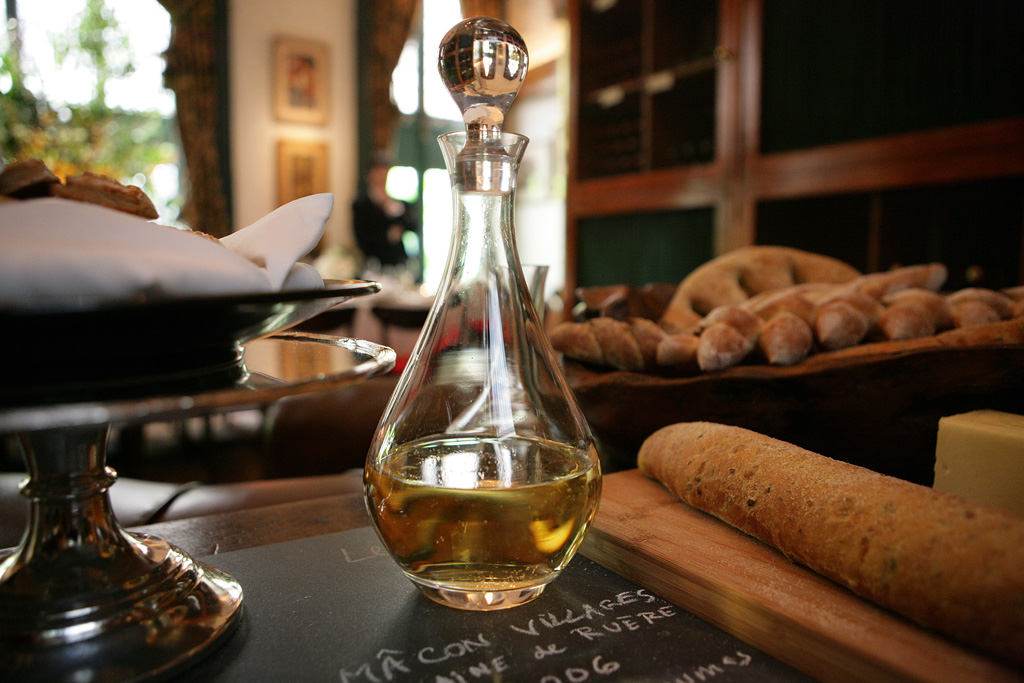
Restaurateurs get equally antsy about selling
very old, very expensive wines on their list, which
are sometimes there more for show than anything else.
While policies differ from restaurant to restaurant,
many will absorb the cost of a verifiable bad bottle
on their list bought by a guest. “We can’t put warning
labels on our wines,” says Charles Masson, owner of
NYC’s La Grenouille (right),
whose clientele tends to be very affluent and very
faithful. “There is always a risk in storing very old
wines. But if a bottle is truly bad, we will not make
our guest pay for it.”
And is a guest spurns a bottle
because he simply doesn’t care for the taste or
erroneously insists it’s gone bad? “It’s an awkward
situation,” says Masson, “but then we do charge for
the wine if we know it’s sound.”
As La Grenouille replenishes its
list, Masson is stocking less and less older vintages,
because, he says, “the prices are now so high and
there is a diminished demand from our clientele. We
actually encourage them to try a younger less
expensive wine more conducive to the meal rather than
go for the 1998 Haut-Brion on our list that costs
$2,250.”
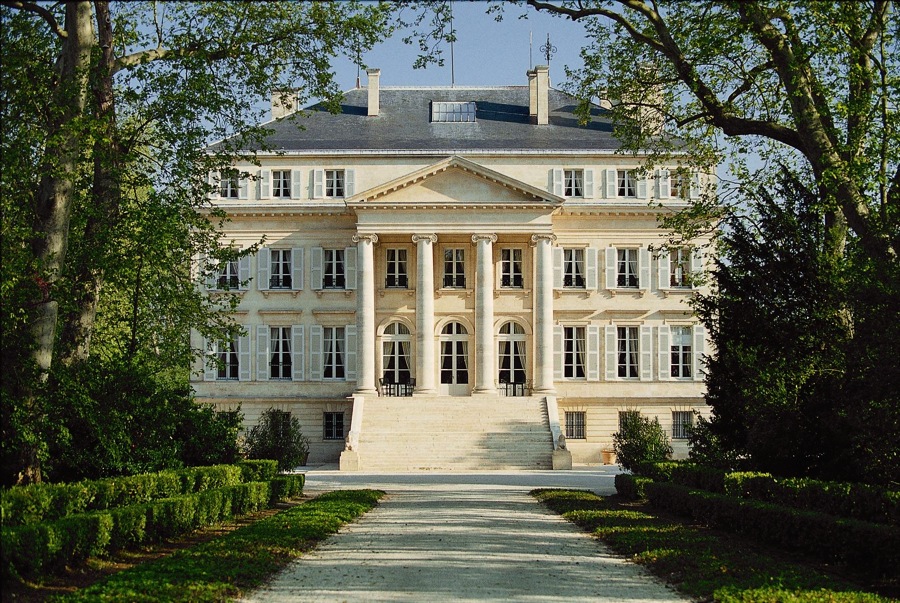 The
tradition of drinking very old wines is actually more
British than French, especially among those Brits who
have for centuries been so involved in the French wine
trade. But technology and contemporary preference have
made the idea of drinking younger, fresher, dependable
wines more reasonable than taking a risk on an old one
whose best days may well be behind it.
The
tradition of drinking very old wines is actually more
British than French, especially among those Brits who
have for centuries been so involved in the French wine
trade. But technology and contemporary preference have
made the idea of drinking younger, fresher, dependable
wines more reasonable than taking a risk on an old one
whose best days may well be behind it.
“An average vintage will age and pass its peak
faster,” says Corinne Mentzelopoulos, owner of the
First Growth Château Margaux (left and below)
in Bordeaux. “But great vintages, such as 1953, 1959,
and 1961 are today the best and the most moving
experiences one can have and kept by the wine
connoisseurs who know those wines might still get
better with further aging.”
By the same token
Mentzelopoulos believes that modern viticulture allows
her more leeway in how she makes her wines: “Thanks to
the considerable improvements we have made in the
vines, we can wait and pick the grapes when we believe
them to have achieved maturity, which I find is one of
the major changes at Margaux and in Bordeaux.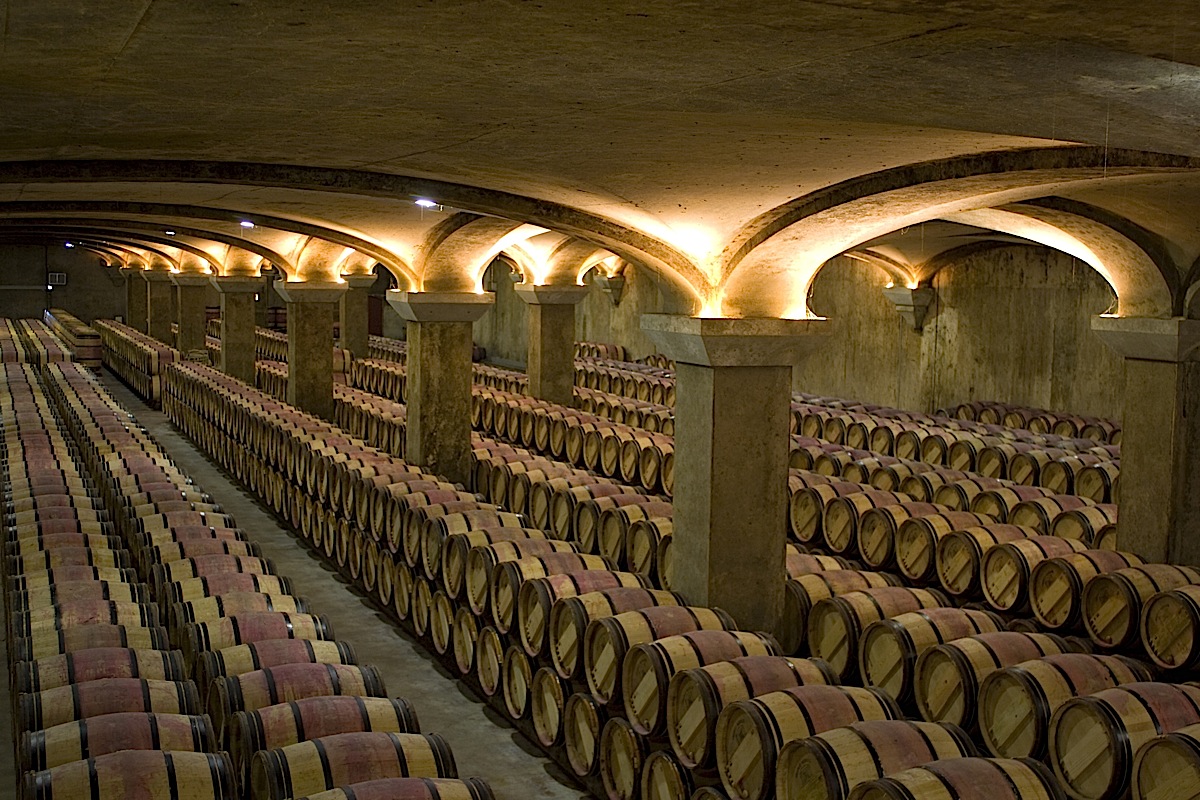 In the past
growers had to bring the grapes in more or less before
the rot would settle in.
In the past
growers had to bring the grapes in more or less before
the rot would settle in.
“In great vintages and with a
better climate we can now harvest at an optimum time,
when the tannins are ripe and therefore softer, making
our wines more pleasant to drink from the beginning.
So, yes, they can be drunk earlier - although there
are some vintages which remain very harsh when young,
bearing in mind that in our case and in good to great
vintages it is still better to wait.”
Still, Mentzelopoulos cautions that “Our wines,
together with some estates from Burgundy, are the only
ones in the world to improve as they age. Wines of
other regions and lesser vintages in Bordeaux and in
Burgundy have indeed to be drunk earlier because they
will pass their peak faster.”
In other words, it seems that wines, like the
people who drink them, will all age, but very few do
it gracefully—a good thing to keep in mind when
ordering any wine older than yourself.
Photo by Mike Coode
John Mariani's wine column appears in Bloomberg Muse News, from which this story was adapted. Bloomberg News covers Culture from art, books, and theater to wine, travel, and food on a daily basis.
❖❖❖
GUESS WHERE THEY THREW THE
RECEPTION?
Jack in the
Box is now serving a Bacon Milkshake, which goes along
with the fast food chain's grotesque new ad campaign
that includes a video
of a man who announces he is marrying bacon, and is
married in a church where the cleric says, "You may
now eat the bride."
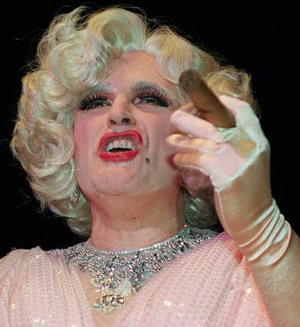
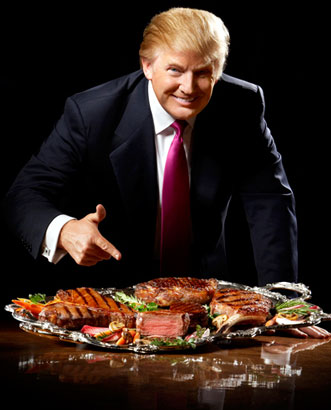
 YOU MIGHT AS WELL THROW IN RUDY
GIULIANI TOO
YOU MIGHT AS WELL THROW IN RUDY
GIULIANI TOO
"Think of
Boar’s Head, finally, as a pushy New Yorker. A pushy New
Yorker who, after years of attention-hogging, becomes
perversely lovable. Boar’s Head is Donald Trump.
It is Al Sharpton. What is Boar’s Head? It is the meat
that will not go away."--Bryan Curtis, "Meat of the People," Slate Magazine
(1/31/12).
Any of John Mariani's
books below may be ordered from amazon.com.
 |
My latest book, which just won the prize for best book from International Gourmand, written with Jim Heimann and Steven Heller, Menu Design in America, 1850-1985 (Taschen Books), has just appeared, with nearly 1,000 beautiful, historic, hilarious, sometimes shocking menus dating back to before the Civil War and going through the Gilded Age, the Jazz Age, the Depression, the nightclub era of the 1930s and 1940s, the Space Age era, and the age when menus were a form of advertising in innovative explosions of color and modern design. The book is a chronicle of changing tastes and mores and says as much about America as about its food and drink.
“Luxuriating vicariously in the pleasures of this book. . . you can’t help but become hungry. . .for the food of course, but also for something more: the bygone days of our country’s splendidly rich and complex past. Epicureans of both good food and artful design will do well to make it their coffee table’s main course.”—Chip Kidd, Wall Street Journal.
“[The menus] reflect the amazing craftsmanship that many restaurants applied to their bills of fare, and suggest that today’s restaurateurs could learn a lot from their predecessors.”—Rebecca Marx, The Village Voice. |
"Eating Italian will never be the same after reading John Mariani's entertaining and savory gastronomical history of the cuisine of Italy and how it won over appetites worldwide. . . . This book is such a tasteful narrative that it will literally make you hungry for Italian food and arouse your appetite for gastronomical history."--Don Oldenburg, USA Today. "Italian
restaurants--some good, some glitzy--far
outnumber their French rivals. Many of
these establishments are zestfully described
in How Italian Food Conquered the World, an
entertaining and fact-filled chronicle by
food-and-wine correspondent John F.
Mariani."--Aram Bakshian Jr., Wall Street
Journal.
"Equal parts
history, sociology, gastronomy, and just
plain fun, How Italian Food Conquered the
World tells the captivating and delicious
story of the (let's face it) everybody's
favorite cuisine with clarity, verve and
more than one surprise."--Colman Andrews,
editorial director of The Daily
Meal.com. "A fantastic and fascinating
read, covering everything from the influence
of Venice's spice trade to the impact of
Italian immigrants in America and the
evolution of alta cucina. This book will
serve as a terrific resource to anyone
interested in the real story of Italian
food."--Mary Ann Esposito, host of PBS-TV's
Ciao
Italia. "John Mariani has written the
definitive history of how Italians won their
way into our hearts, minds, and
stomachs. It's a story of pleasure over
pomp and taste over technique."--Danny Meyer,
owner of NYC restaurants Union Square Cafe,
Gotham Bar & Grill, The Modern, and
Maialino.
|
 |
 |
 |
 |
 |
 |
 |
 |
 Everett Potter's Travel Report:
Everett Potter's Travel Report: 
 Eating Las Vegas
is the new on-line site for Virtual Gourmet
contributor John A. Curtas., who since 1995
has been commenting on the Las Vegas food
scene and reviewing restaurants for Nevada
Public Radio. He is also the
restaurant critic for KLAS TV, Channel 8 in
Las Vegas, and his past reviews can be
accessed at KNPR.org.
Click on the logo below to go directly to
his site.
Eating Las Vegas
is the new on-line site for Virtual Gourmet
contributor John A. Curtas., who since 1995
has been commenting on the Las Vegas food
scene and reviewing restaurants for Nevada
Public Radio. He is also the
restaurant critic for KLAS TV, Channel 8 in
Las Vegas, and his past reviews can be
accessed at KNPR.org.
Click on the logo below to go directly to
his site.

Tennis Resorts Online: A Critical Guide to the World's Best Tennis Resorts and Tennis Camps, published by ROGER COX, who has spent more than two decades writing about tennis travel, including a 17-year stretch for Tennis magazine. He has also written for Arthur Frommer's Budget Travel, New York Magazine, Travel & Leisure, Esquire, Money, USTA Magazine, Men's Journal, and The Robb Report. He has authored two books-The World's Best Tennis Vacations (Stephen Greene Press/Viking Penguin, 1990) and The Best Places to Stay in the Rockies (Houghton Mifflin, 1992 & 1994), and the Melbourne (Australia) chapter to the Wall Street Journal Business Guide to Cities of the Pacific Rim (Fodor's Travel Guides, 1991).


The Family Travel Forum - A
community for those who "Have Kids, Still Travel" and
want to make family vacations more fun, less work and
better value. FTF's travel and parenting features,
including reviews of tropical and ski resorts, reunion
destinations, attractions, holiday weekends, family
festivals, cruises, and all kinds of vacation ideas
should be the first port of call for family vacation
planners. http://www.familytravelforum.com/index.html
ALL YOU NEED BEFORE YOU GO


MARIANI'S VIRTUAL GOURMET
NEWSLETTER is published weekly. Editor/Publisher: John
Mariani.
Contributing Writers: Christopher Mariani, Robert Mariani,
John A. Curtas, Edward Brivio, Mort Hochstein,
Suzanne Wright, and Brian Freedman. Contributing
Photographers: Galina Stepanoff-Dargery,
Bobby Pirillo. Technical Advisor: Gerry McLoughlin.
© copyright John Mariani 2012
